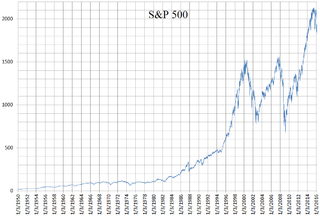Related Research Articles

The dot-com bubble was a stock market bubble that ballooned during the late-1990s and peaked on Friday, March 10, 2000. This period of market growth coincided with the widespread adoption of the World Wide Web and the Internet, resulting in a dispensation of available venture capital and the rapid growth of valuations in new dot-com startups.

The Nasdaq Stock Market is an American stock exchange based in New York City. It is the most active stock trading venue in the US by volume, and ranked second on the list of stock exchanges by market capitalization of shares traded, behind the New York Stock Exchange. The exchange platform is owned by Nasdaq, Inc., which also owns the Nasdaq Nordic stock market network and several U.S.-based stock and options exchanges.

The Dow Jones Industrial Average (DJIA), Dow Jones, or simply the Dow, is a stock market index of 30 prominent companies listed on stock exchanges in the United States.

A stock market crash is a sudden dramatic decline of stock prices across a major cross-section of a stock market, resulting in a significant loss of paper wealth. Crashes are driven by panic selling and underlying economic factors. They often follow speculation and economic bubbles.

The Standard and Poor's 500, or simply the S&P 500, is a stock market index tracking the stock performance of 500 of the largest companies listed on stock exchanges in the United States. It is one of the most commonly followed equity indices and includes approximately 80% of the total market capitalization of U.S. public companies.

Nasdaq Stockholm, formerly known as the Stockholm Stock Exchange, is a stock exchange located in Frihamnen, Stockholm, Sweden. Founded in 1863, it has become the primary securities exchange of the Nordic countries. As of March 2021, a total of 832 companies are listed on Nasdaq Stockholm with 385 companies on the main market and additional 447 listed on secondary markets.

The Nasdaq-100 (^NDX) is a stock market index made up of 101 equity securities issued by 100 of the largest non-financial companies listed on the Nasdaq stock exchange. It is a modified capitalization-weighted index. The stocks' weights in the index are based on their market capitalizations, with certain rules capping the influence of the largest components. It is limited to companies from a single exchange, and it does not have any financial companies. The financial companies are in a separate index, the Nasdaq Financial-100.
The Center for Research in Security Prices, LLC (CRSP) is a provider of historical stock market and investable index data. CRSP is an affiliate of the Booth School of Business at the University of Chicago. CRSP maintains some of the largest and most comprehensive proprietary historical databases in stock market research. Academic researchers and investment professionals rely on CRSP for accurate, survivor bias-free information which provides a foundation for their research and analyses. As of 2023, CRSP claims over 600 clients. The name is usually pronounced "crisp".
A capitalization-weightedindex, also called a market-value-weighted index is a stock market index whose components are weighted according to the total market value of their outstanding shares. Every day an individual stock's price changes and thereby changes a stock index's value. The impact that individual stock's price change has on the index is proportional to the company's overall market value, in a capitalization-weighted index. In other types of indices, different ratios are used.
The Nasdaq Composite is a stock market index that includes almost all stocks listed on the Nasdaq stock exchange. Along with the Dow Jones Industrial Average and S&P 500, it is one of the three most-followed stock market indices in the United States. The composition of the NASDAQ Composite is heavily weighted towards companies in the information technology sector. The Nasdaq-100, which includes 100 of the largest non-financial companies in the Nasdaq Composite, accounts for over 90% of the movement of the Nasdaq Composite.
The NYSE Composite (^NYA) is a stock market index covering all common stock listed on the New York Stock Exchange, including American depositary receipts, real estate investment trusts, tracking stocks, and foreign listings. It includes corporations in each of the ten industries listed in the Industry Classification Benchmark. It uses free-float market cap weighting.
The Value Line Composite Index (VLCI) are two futures market indices published by Value Line, both comprising 1,681 publicly listed companies on the NYSE, NYSE American, NASDAQ, and TSX stock exchanges. They include all components of the company's Value Line Investment Survey except for closed-end funds, designed to be representative of the North American equity market. The VLCI was initially released on June 30, 1961 as the Value Line Geometric Composite Index, a equally weighted index using a geometric average. Since February 1, 1988 the VLCI has also included the Value Line Arithmetic Composite Index, a similar index that instead uses a arithmetic average.
NASDAQ futures are financial futures which launched on June 21, 1999. It is the financial contract futures that allow an investor to hedge with or speculate on the future value of various components of the NASDAQ market index.
This article is a summary of the closing milestones of the S&P 500 Index, a United States stock market index.
The Barron's 400 Index or B400 is a stock market index of 400 public companies in the United States, as selected by editors and associates of Barron's magazine. Established in 2007, the Barron's 400 has tended to outperform certain other major indexes at least through the first half of 2013.
This article is a summary of the closing milestones of the Nasdaq Composite, a United States stock market index. Since first opening at 100.00 on February 5, 1971, the Nasdaq Composite has increased, despite several periods of decline, most recently after the financial crisis.